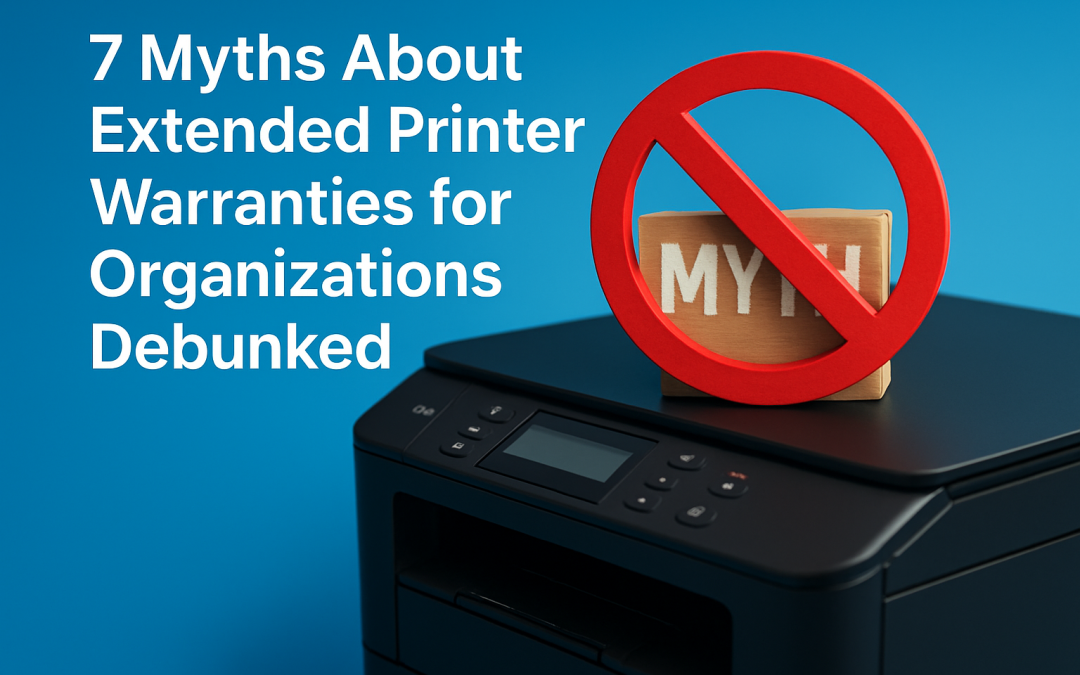7 Myths About Extended Printer Warranties for Organizations Debunked
If your teams depend on reliable printing every day, you have likely wondered whether extended printer warranties for organizations are actually worth it. The short answer: yes, when they are chosen strategically. In busy offices, schools, and government departments, unplanned downtime ripples across deadlines and budgets. Yet misconceptions persist, from “reliable devices never fail” to “leasing already covers it all.” In this balanced guide, you will learn what extended coverage really includes, how it affects total cost of ownership (TCO [total cost of ownership]), and how to compare plans with confidence. Throughout, we will show how PrintCom’s Perth-based team aligns warranties with maintenance, consumables, and fleet right-sizing to reduce monthly running costs without sacrificing print quality.
Why Warranties Matter in Organizational Printing
Printers and photocopiers are miniature production lines. Rollers, fuser units, transfer belts, and sensors all wear over time, particularly under multi-shift workloads. Industry benchmarks indicate that printing can consume 1 to 3 percent of company revenue, and unplanned outages may multiply costs due to rushed service calls, emergency parts, and idle staff. When you add variability across brands and models, the administrative burden grows. An extended warranty transforms unpredictable break-fix events into scheduled interventions with clear service level agreements (SLA [service level agreement]) and parts coverage. That predictability is the foundation for lower risk and a steady budget.
Moreover, modern print fleets carry security and compliance implications. Device security and data-handling procedures need attention across the lifespan of a device. Extended coverage that includes proactive maintenance and qualified technicians can shorten the window between issue detection and fix, limiting exposure. PrintCom’s qualified on-site repair technicians routinely perform health checks during warranty visits, helping ensure devices remain aligned with vendor guidance. That pairing of coverage and care helps organizations simplify multi-brand support, especially when devices come from Brother (Brother Industries), Kyocera (Kyocera Corporation), HP (Hewlett-Packard), OKI (Oki Electric Industry), Fuji Xerox (Fujifilm Business Innovation), and Samsung (Samsung Electronics).
7 Myths About Extended Printer Warranties for Organizations
Myth 1: “If we buy reliable brands, we do not need extra coverage.”
Watch This Helpful Video
To help you better understand extended printer warranties for organizations, we’ve included this informative video from The Ramsey Show Highlights. It provides valuable insights and visual demonstrations that complement the written content.
High-quality brands reduce risk, but they do not eliminate it. Even robust office models have wear components designed for replacement after a certain page count. Industry field data suggests 15 to 25 percent of devices will need at least one major component outside the first year, particularly in busy workgroups. Extended coverage turns those events into budgeted line items, often including labor, travel, and genuine parts. PrintCom, as an authorized dealer for Brother (Brother Industries), Kyocera (Kyocera Corporation), HP (Hewlett-Packard), OKI (Oki Electric Industry), Fuji Xerox (Fujifilm Business Innovation), and Samsung (Samsung Electronics), aligns coverage with each brand’s maintenance kits so that wear items are swapped before they trigger downtime.
Myth 2: “Extended plans just duplicate the manufacturer warranty.”
Base warranties are typically short and limited. The common baseline is 12 months, depot-only service, and exclusions for consumables. Extended plans expand time and depth: on-site response, faster SLAs (service level agreements), coverage for critical assemblies, and sometimes loan devices. In practice, that means fewer disruptions and less procurement effort chasing quotes and approvals for every breakdown. PrintCom’s extended options reach up to five years, often with on-site repair included and parts pre-authorized, so your administrators spend less time on paperwork and your users get back to work faster.
Myth 3: “Only very large enterprises benefit.”
Small and medium-sized organizations feel downtime more acutely because they do not have redundant devices on every floor. A stalled accounts payable run or delayed student reports eats into core operations. By aggregating coverage across a mixed fleet, smaller teams gain enterprise-level predictability without enterprise headcount. PrintCom structures plans for a handful of devices or hundreds, matching usage profiles and monthly page volumes. Many of our Perth customers report noticeable productivity gains once they stop firefighting and start scheduling, even with fewer than ten devices.
Myth 4: “You must service with the original manufacturer.”
Manufacturers set standards, but authorized partners are trained to them. An authorized dealer like PrintCom maintains direct access to parts and escalation channels across multiple brands. That multi-vendor capability is precisely what most organizations need, as few fleets are single-brand anymore. Instead of juggling separate helpdesks and contracts, you receive one plan, one response target, and one technician who understands the whole environment. This unified approach shortens resolution time and reduces the cost of coordinating multiple vendors.
Myth 5: “Extended warranties lock us into expensive consumables.”
It depends on the plan. Some coverage requires original supplies to protect device reliability, while other plans allow compatible options if they meet quality thresholds. The key is clarity. PrintCom will map consumable policies to your budget and print quality needs, advising where original toner or ink secures better yield or prevents wear. When we do recommend OEM (original equipment manufacturer) supplies, it is because the data shows fewer service incidents and better print density, which in turn preserves uptime and lowers the long-run cost per page.
Myth 6: “Leased or rented devices are already fully covered.”
Lease agreements vary widely. Some include next-business-day on-site repair and maintenance kits; others only cover catastrophic failure and exclude fuser assemblies, rollers, or image drums. Gaps often surface in the second or third year, when parts reach end-of-life. PrintCom’s rental and leasing options are transparent about inclusions, and we offer add-on extended coverage to close gaps explicitly. That way, whether you lease, rent, or buy outright, your protection matches your risk tolerance and usage profile without surprise invoices.
Myth 7: “Claims are slow and complicated.”
They can be, but they do not have to be. The difference is process design and local technician capacity. PrintCom operates with streamlined intake, serial number lookup, and pre-approved parts for covered models. Because our qualified technicians provide on-site services, most issues are resolved in a single visit. Where a device must be taken off-site, we discuss a loan unit so core workflows continue. Clear steps, local stock, and measured SLAs (service level agreements) turn “claims” into routine maintenance events your staff barely notice.
Cost Comparison: Warranty vs. Ad-hoc Repairs

Numbers tell the story. Consider a 25-device mixed fleet in a standard office setting. Without extended coverage, budget owners approve each repair as it appears, often at premium callout rates. Parts for mid-range A4 lasers and MFP (multifunction printer) devices are not trivial, and emergency visits cost more. With extended coverage, costs are packaged, response times are defined, and wear components are replaced on schedule. This reduces unplanned interruptions and cuts administrative effort. While figures vary by brand and duty cycle, the pattern is consistent: a steady annual fee beats sporadic spikes. The table below illustrates an example scenario using conservative estimates drawn from vendor rate cards and field averages.
| Cost Area | Ad-hoc Repairs (Annual) | Extended Coverage (Annual) | Notes |
|---|---|---|---|
| Service Callouts | $6,250 (25 calls x $250) | Included | Typical 1 call per device per year across the fleet |
| Major Parts | $7,500 (3 fuser/roller sets) | Included on covered models | Replacements often needed in years 2–3 |
| Downtime Cost | $9,000 (150 hrs x $60/hr impact) | $3,000 (50 hrs x $60/hr impact) | Reduced by faster on-site response |
| Admin/Procurement Time | $1,200 (40 hrs x $30/hr) | $300 (10 hrs x $30/hr) | Fewer quotes and approvals |
| Annualized Cost | $23,950 | $12,300 | Extended coverage fee for 25 devices |
Even if your inputs differ, the direction typically holds. Extended plans shift you from reactive spending to predictable budgeting, while improving user experience. When PrintCom matches coverage to the duty cycle and environment, organizations often see fewer urgent calls and longer device lifespans, compounding savings across three to five years. It is a pragmatic path to lower TCO (total cost of ownership) and calmer Mondays.
How to Evaluate an Extended Warranty Provider
Not all plans are created equal. To make a confident selection, inspect the fine print and the delivery capability behind it. Ask how response times are measured, which parts are covered, whether consumables are included, and how loan units are handled during repairs. Your goal is to replace uncertainty with clarity, and promises with track record. Authorized partners typically have better access to parts and escalation channels, but you should still verify local stock levels and technician availability, especially in regional areas.
Next, consider the broader service ecosystem. Will the provider help optimize fleet size, advise on print policies, and supply consumables under one invoice? When coverage is part of a comprehensive plan, you capture value beyond break-fix repairs. PrintCom integrates coverage with maintenance contracts and consumables supply, and because we sell and lease devices as well, we can right-size models to your workloads. This makes it easier to meet sustainability goals, minimize waste, and ensure high uptime without overbuying.
| Evaluation Criterion | Manufacturer Plan | Authorized Dealer (PrintCom) | Third-Party Plan |
|---|---|---|---|
| On-Site Response SLA (service level agreement) | Varies by model | ✓ Next-business-day in metro areas | Varies; check fine print |
| Multi-Brand Coverage | Usually single brand | ✓ Brother, Kyocera, HP, OKI, Fuji Xerox, Samsung | Depends on provider |
| Loan Device Option | Limited availability | ✓ Available on request | Sometimes offered |
| Parts and Labor Included | Often partial | ✓ Clearly itemized, up to 5 years | Check exclusions |
| Consumables Policy | OEM (original equipment manufacturer) required | ✓ Advisory approach to cost and quality | Varies |
| Fleet Optimization Advice | Limited | ✓ Included with maintenance contracts | Rare |
- Clarify coverage of fuser units, drums, rollers, and image transfer belts.
- Confirm response time windows and escalation paths for critical workflows.
- Ask about device security and data-handling procedures.
- Verify availability of local qualified technicians and spare parts stock.
- Request example invoices to see what “included” truly means in practice.
How PrintCom Reduces Risk and Cost Across Your Fleet
PrintCom is a Perth-based provider with over 35 years of experience across computers, printers, photocopiers, fax machines, and scanners. We combine extended coverage with practical services: qualified on-site technicians, maintenance contracts, consumables supply, and rental or leasing options. As an authorized dealer for Brother (Brother Industries), Kyocera (Kyocera Corporation), HP (Hewlett-Packard), OKI (Oki Electric Industry), Fuji Xerox (Fujifilm Business Innovation), and Samsung (Samsung Electronics), we support mixed fleets with one set of terms and one phone number. Our extended warranties can run up to five years, aligning parts replacement with duty cycles so devices stay productive without nasty surprises.
Beyond coverage, we address the root causes of printing pain: high monthly costs, unreliable devices, and the hassle of juggling models. Our team helps right-size devices to fit real usage, tunes drivers and defaults to lower waste, and schedules proactive maintenance. For organizations that prefer flexibility, our printer rental and leasing options include clear-service inclusions and upgrade paths. This holistic approach routinely lowers monthly running costs while improving user satisfaction, because your staff see fewer jams and faster fixes when issues do occur.
| PrintCom Capability | What It Means for You | Business Outcome |
|---|---|---|
| Extensive range of printers and photocopiers | Right device for each team and workload | Lower TCO (total cost of ownership) and higher uptime |
| Qualified on-site repair technicians | Fast diagnosis and first-visit fix | Less downtime and fewer escalations |
| Extended warranties up to 5 years | Predictable coverage for parts and labor | Smoother budgeting, fewer surprise bills |
| Maintenance contracts and consumables supply | One invoice, proactive servicing | Administrative simplicity, consistent print quality |
| Printer rental and leasing options | Flexible scaling and upgrade paths | Capacity when needed without overbuying |
Case example: A Perth design studio with twelve devices faced weekly outages and scattered suppliers. PrintCom consolidated to a balanced fleet from Kyocera (Kyocera Corporation) and HP (Hewlett-Packard), added a four-year extended plan with on-site coverage, and set duplex and toner-save defaults. Over 12 months, service calls dropped 38 percent, time-to-fix fell below one business day, and monthly print spend decreased by 22 percent. The studio’s teams noticed what matters most: they could click Print and keep moving.
Implementation Checklist and Best Practices

Bringing extended coverage into your environment is a chance to tidy up the whole print picture. Start with an inventory: models, page counts, age, and fault history. Then segment by role—front desk, finance, classroom, production—and map service criticality. With this view, you can select coverage terms that match reality rather than guesses. Finally, keep governance simple: one contact channel, documented SLAs (service level agreements), and quarterly reviews of usage and incidents. The steps below will get you there without drama.
- Audit the fleet: capture serial numbers, meter readings, and current software/configuration versions.
- Classify devices by criticality and peak usage windows to prioritize response times.
- Identify wear components near end-of-life to schedule replacements under coverage.
- Agree on consumables policy and stock thresholds to prevent last-minute purchases.
- Define escalation paths and a loan-device policy for high-stakes workflows.
- Schedule quarterly reviews with PrintCom to align coverage with changing needs.
Myths vs. Realities at a Glance
If you need a quick reference for your next budget meeting, this summary table captures the essence of the seven myths and what to say when they arise. Keep it handy to guide stakeholders toward data-driven decisions instead of gut feelings. When you combine these realities with practical steps and a capable partner, you gain predictable costs and dependable printing.
| Myth | Reality | What to Ask |
|---|---|---|
| Reliable brands do not need coverage | Wear parts still fail under load | Which wear items are included and when are they replaced? |
| Extended plans duplicate base warranty | They extend time and depth of service | What are the on-site SLAs (service level agreements) and parts inclusions? |
| Only large enterprises benefit | Small teams gain predictability and speed | Can coverage scale for fewer than ten devices? |
| Service must be manufacturer-only | Authorized dealers meet brand standards | Are you authorized for our device mix? |
| Coverage locks in expensive consumables | Policies vary; clarity reduces risk | Which supplies are required and why? |
| Leases always include everything | Gaps exist in many agreements | Which parts are excluded after year two? |
| Claims are slow and complex | Process and local stock speed fixes | How are calls triaged and tracked? |
Ready to put the myths behind you? With the right plan, extended coverage is not an extra—it is the practical way to keep people productive and budgets steady. PrintCom can scope options across its extensive range of printers and photocopiers, match coverage to your usage, and put trained technicians on your doorstep when needed.
Conclusion
Seven myths fall away when you see how the right coverage improves uptime, reduces surprises, and simplifies multi-brand support.
Imagine the next 12 months with faster fixes, fewer urgent emails, and printing that quietly works while your teams focus on mission-critical tasks.
What would change for your staff if extended printer warranties for organizations turned every breakdown into one predictable, well-managed service visit?
Additional Resources
Explore these authoritative resources to dive deeper into extended printer warranties for organizations.
Elevate Warranty Strategy with Printcom’s Diverse Printer Range
Empower your organization with an extensive range of printers and photocopiers plus tailored support, on-site repairs, and rental options for cost-effective, reliable protection.

